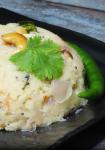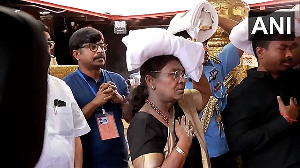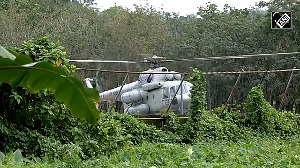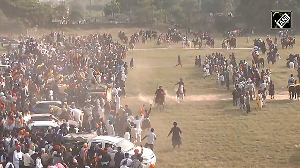It was a year that threw up a star, brought down another and saw several in the making, pitchforking India on the sporting map of the world like perhaps never before.
 Sania Mania gripped the nation and forced the West to sit up and take notice of the raging teen talent who rewrote history books with her exploits at various Grand Slams as well as in Tour events home and away.
Sania Mania gripped the nation and forced the West to sit up and take notice of the raging teen talent who rewrote history books with her exploits at various Grand Slams as well as in Tour events home and away.
Her status as the new star on the Indian sporting horizon could be gauged from the simple figure -- she started the year ranked world number 169 but ended it on 34.
Danglers and whacky T Shirt-sporting Sania became the first Indian to win a WTA event and the first to reach the fourth round of a Grand Slam during the 2004 US Open where pitted against the Indian was no other but top-ranked Russian beauty Maria Sharapova.
Sania lost in straight sets but by then the Hyderabadi Hurricane had taken the world by storm with her exploits on the court and off it.
During the year, she also upset 2004 US Open champion Russian Svetlana Kuznetsova at the Dubai Open.
Sania has now set upon herself to breach more barriers in the season ahead, armed with a new fitness staff and a stint with legendary Tony Roche, who also coached Roger Federer.
Cricket was rocked by controversies centered around Sourav Ganguly.
The image of a sulking Sourav Ganguly splashed across the dailies would linger on for long after the 'Prince of Kolkata' was treated like a commoner and left facing the prospect of carrying drinks for the very teammates he had not long ago led with aplomb.
 But this travesty of fate was averted with the national selectors finally deciding to throw a lifeline to the most successful captain of India in the form of a berth in the Test squad which will tour Pakistan next month.
But this travesty of fate was averted with the national selectors finally deciding to throw a lifeline to the most successful captain of India in the form of a berth in the Test squad which will tour Pakistan next month.
Some believe it was Ganguly's own doings that brought on him such times -- it was he who ignited the controversy in the first place by revealing the sacred dressing room going-ons to an obliging press.
Ganguly's revelation that newly-appointed coach Greg Chappell had asked him to step down in the midst of the tour of Zimbabwe kicked off what was the biggest controversy to hit the sport after the match-fixing scandal of 2000.
Chappell then may well have pointed the (now-infamous) 'finger' at Ganguly by his outpourings in an e-mail that was scandalously leaked to the media.
The Australian's charge -- that Ganguly was unfit physically and mentally to lead the side -- caused much heartburn to his die-hard fans and sadistic pleasure to his denouncers.
Copious behind-the-scene drama accompanied Ganguly's absence from the Challenger Series domestic limited overs tournament, presence in the team for the two Tests against Sri Lanka (he was dropped from the third) and anticipated presence in the squad for Pakistan.
But the unsavoury Sourav Soap Opera apart, the Indian team quietly lifted its sagging fortunes late in the year under new skipper Rahul Dravid with whopping wins in both the one-dayers and Tests against Sri Lanka. They also drew 2-2 with South Africa in a one-day series at home.
India also registered their first series win outside the sub-continent since 1986 when they won in Zimbabwe, but the quality of the opposition took the shine off the achievement of Ganguly's men.
However, all was not hunky-dory as the Indians suffered the ignominy of losing to arch-rivals Pakistan in the one-day series at home and splitting honours in the preceding three-Test series.
Somehow, the one-day bug seemed unwilling to leave India earlier in the year as the team also lost a tri-series each in Sri Lanka and Zimbabwe.
What came as a breath of fresh air was exciting prospects in young wicketkeeper-batsman Mahendra Singh Dhoni and Irfan Pathan.
Among the tried and tested, Sachin Tendulkar made a successful return from a painful elbow injury and duly erased Sunil Gavaskar's record for maximum Test centuries by hitting his 35th ton against Sri Lanka.
He showed glimpses of vintage form during some of his one-day knocks but that was about all as fans were left asking for more from the master batsman.
A change in the set-up at BCCI, following court-room battles and mud slingings galore from Jagmohan Dalmiya and Sharad Pawar camps, promised better times from days of anarchy and unprofessionalism.
If one sport cut a really sorry figure, it was hockey which touched the nadir in what was ironically the birth centenary of legendary Dhyan Chand.
India finished at the bottom of the tables in all the three international tournaments they participated in -- 5th in seven-nation Azlan Shah tournament in Malaysia in May, 7th in eight-nation Rabo tournament in Holland in August and 6th in six-nation Champions Trophy played in Chennai in December.
The sacking of German coach Gerhard Rach, who called Indian Hockey Federation a "madhouse" and the flip-flops by IHF also added to the disillusionment of the fans.
Rajinder Singh Jr was given the charge of the team but the step hardly made any difference to the performance graph of the Indian team.
A largely lacklustre year in Indian football ended on a positive note when the national team regained its regional supremacy by winning the SAFF Championship in Karachi.
The championship was the first assignment for Syed Nayeemuddin, who took over as national coach in October for the third time.
The coach also brought back Baichung Bhutia, with whom he had had differences in the past, as skipper, and the Sikkimese striker repaid the faith by scoring in the SAFF Cup final against Bangladesh.
 In motorsports, Narain Karthikeyan put India on the Formula One map for the first time ever. After an eventful season with Jordan Grand Prix, which culminated with his involvement in a spectacular crash in the season-ending race in Shanghai, Narain was weighing his limited options in the coming season. However, credit should be given to the doughty Indian for blazing the trail for other aspiring enthusiasts to dream big in motorsports.
In motorsports, Narain Karthikeyan put India on the Formula One map for the first time ever. After an eventful season with Jordan Grand Prix, which culminated with his involvement in a spectacular crash in the season-ending race in Shanghai, Narain was weighing his limited options in the coming season. However, credit should be given to the doughty Indian for blazing the trail for other aspiring enthusiasts to dream big in motorsports.
As for athletics, the year would be remembered not only for the glory brought to the country by long jump queen Anju Bobby George and other talented youngsters but also for doping scandals which are sadly becoming regular occurrences.
Anju, lay low for most of the first six months of 2005 owing to illness and injury but sprang to limelight in September, winning the gold at the 16th Asian Athletics Championship in Incheon, South Korea.
After becoming the first Indian to make it to the World Athletics Finals in Monaco, Anju made history yet again by claiming silver in the elite eight-women field.
The Indian climbed to the fourth spot in the long jump rankings of the International Association of Athletics Federations. She is the only Asian in top 20 of the list.
Neelam Jaswant Singh found herself embroiled in a doping scandal while weightlifters reaped the harvest of their own doings at the Athens Olympics last year, having to undergo a year-long ban.
Boxing gave the country a starlet in M C Mery Kom who successfully spearheaded the team to its maiden title triumph in the Asian Championship. Mery Kom also returned with the gold from the World Boxing Championship.
Indian shooters reigned at the Asian Championships at Bangkok, which they swept for the first time with Rajyavardhan Singh Rathore becoming the first-ever shooter to emerge winner three times on the trot, and the Commonwealth Championships, where they emerged on top with 28 medals, including 14 gold.
However, it was a none-too-impressive performance in the four World Cups as only a few Indians made it to the finals. But none of them could lay their hands on even a single quota place on offer for the first time in the immediate next year after the Olympics.
Also read:
- Indian cheers on the 64-square






